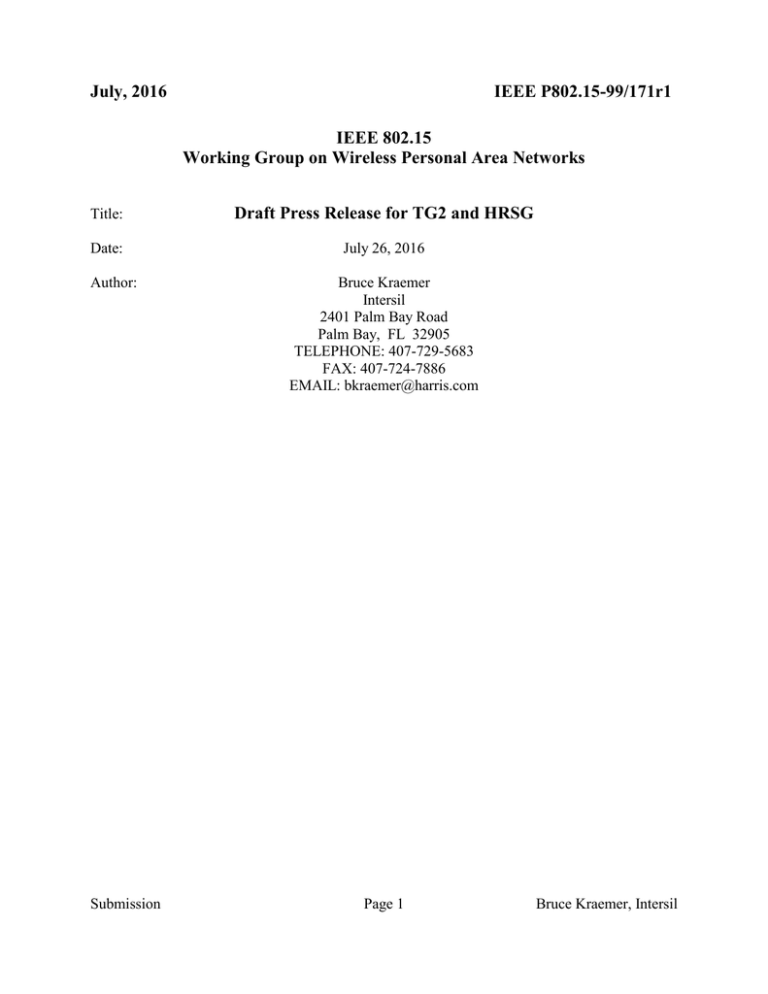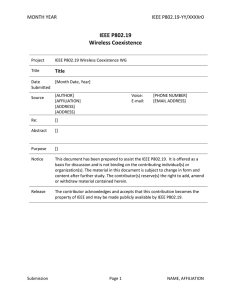July, 2016 IEEE P802.15-99/171r1 IEEE 802.15 Working Group on Wireless Personal Area Networks
advertisement

July, 2016 IEEE P802.15-99/171r1 IEEE 802.15 Working Group on Wireless Personal Area Networks Title: Draft Press Release for TG2 and HRSG Date: July 26, 2016 Author: Submission Bruce Kraemer Intersil 2401 Palm Bay Road Palm Bay, FL 32905 TELEPHONE: 407-729-5683 FAX: 407-724-7886 EMAIL: bkraemer@harris.com Page 1 Bruce Kraemer, Intersil July, 2016 IEEE P802.15-99/171r1 DRAFT---FOR IMMEDIATE RELEASE IEEE Creates Coexistence Task Group and Study Group to Develop High Speed, Wireless Personal Area Networks -- Committees to address performance, interoperability and coexistence issues related to short-range wireless networks in the home and office Austin, TX, Month, date, 2000 – The Institute of Electrical and Electronics Engineers (IEEE) 802 LAN/MAN Standards Committee, Chaired by Jim Carlo, Texas Instruments, announced today that the 802.15 Working Group on Wireless Personal Area Networks has initiated work in two new areas. One area is to develop specifications, called a Recommended Practice, to improve coexistence with other WLAN systems operating in the same band and the other is to initiate activity which will lead to the development of a standard for a high data rate, low-cost Wireless Personal Area Networks (WPANs). The relatively new IEEE 802.15 Working Group is currently engaged in developing a 1 Mbps standard based on the work of the Bluetooth SIG. It is now beginning development of a project definition for a consumer-priced, 20 Mbps High Rate WPAN that can be widely deployed in home and office environments for short-range information transfer, particularly multimedia and digital imaging. Industry leaders including Cisco Systems, Eastman Kodak Company, Intersil Corporation, Motorola, and Symbol Technologies and are backing the new 802.15 initiative. A wireless personal area network, or WPAN, is a low-cost networking scheme that enables computing devices such as PCs, laptop computers, printers and personal digital assistants (PDAs) to wirelessly communicate with each other over short distances. (MORE) Submission Page 2 Bruce Kraemer, Intersil July, 2016 IEEE P802.15-99/171r1 “The IEEE’s goal is to provide the foundation for a broad range of interoperable consumer devices by establishing universally-adopted standards for wireless digital communication anywhere in the home and office,” said Bob Heile, chairman of the 802.15 Working Group and Director of Wireless Opportunity Development for GTE. “The creation of a wireless personal area network protocol plays a critical part of this approach – and we’re confident the creation of a working group is the logical first step.” The IEEE 802.15 Working Group is comprised of several active sub groups. The first major effort, to standardize a low cost, medium data rate WPAN solution was assigned to Task Group 1 (TG1) last summer. TG1 is currently working closely with the Bluetooth SIG to complete this task. Based upon strong industry support of TG1 and interest in increasing both the robustness of wireless solutions and data rates, two additional groups have been formed. Coexistence Task Group A major concern shared by many in the industry is whether various wireless devices based on several standards or specifications can peacefully coexist within the same 2.4 GHz band. The 802.15 Coexistence Task Group (TG2) will address the issue of coexistence between WPANs and other wireless devices such as the IEEE 802.11 Wireless Local Area Networks (WLANs). IEEE 802.11 is a wireless extension to Ethernet that is expected to be widely deployed in office and home environments over the next few years. “The potential for interference between different wireless units – using incompatible protocols such as 802.11b and 802.15 – operating in close proximity and in the same frequency spectrum needs to be investigated and quantified,” said Steve Shellhammer, chairman of the 802.15 Coexistence Task Group (TG2) and a Director at Symbol Technologies. “While it’s critical that we explore different technologies that can meet the requirements of high performance and lowcost, the need for co-existence must be properly addressed.” Submission Page 3 Bruce Kraemer, Intersil July, 2016 IEEE P802.15-99/171r1 The Coexistence Task Group was recently formed and has established as its goals to first fully characterize and understand the effects of mutual interference and then produce a Recommended Practice for WPAN devices operating in a WLAN environment. An extended vision is to assist standards development in minimizing the potential for interference among different radio systems in the shared ISM bands. The 802.15 High Rate Study Group The 802.15 High Rate Study Group will address the technical merits and market requirements for a low cost, high data rate WPANs. If the results of their study warrent, they will develop a Project Authorization Request (PAR) so that a new Task Group within P802.15 can begin work on a draft standard. Initial meetings of the 802.15 Working Group in July outlined data rates of 1-2Mbps for WPANs. The new High Rate Study Group, however, will seek to provide high speed enhancement to the physical (PHY) and medium access control (MAC) layers of 802.15 systems to support data rates of 20Mbps or more. According to Jim Allen, Kodak, who will co-chair the new group within 802.15, “We’re doing this because current standards and bandwidths don’t meet the projected needs of multimedia and digital imaging. The 802.11[a&b] standards address WLAN speed but not the requirements of an embeddable, consumer-priced wireless personal area network. Today’s low bandwidth wireless standards simply do not satisfy the needs for consumer-priced, high data rate systems.” Additional Information For information or to participate Contact Bob Heile (+1-781-466-2057 Voice, bheile@bbn.com), Chair of 802.15. Further information can also be found at the 802.15 WPAN website: http://grouper.ieee.org/groups/802/15/. ++++++++++++++ For more information about the recently published IEEE P802 standards or any of the other IEEE standards call +1 800-678-IEEE (4333), outside of the USA and Canada: call +1 908-981-1393. See also the WEB page at http://grouper.ieee.org/groups/802/ Submission Page 4 Bruce Kraemer, Intersil July, 2016 IEEE P802.15-99/171r1 IEEE P802.15 Working Group is a standards working group on wireless personal area networks The P802.15 Working Group is part of the IEEE 802 LMSC (LAN MAN Standards Committee) responsible for Ethernet, Token Ring, Wireless and Bridging Standards. The IEEE 802 LMSC is sponsored by the IEEE Computer Society and submits standards through the IEEE Standards Association. The IEEE Computer Society is the oldest and largest association of computer professionals in the world. It offers its 100,000 members comprehensive program of publications, meetings, and technical and educational activities, encouraging an active exchange of information, ideas, and innovation. The society is the world's leading publisher of technical material in the computing field. No other professional or commercial organization comes close to matching the Computer Society in terms of the quality, quantity, or diversity of its publications. Headquartered in Washington, DC, the society serves its members from offices in Los Alamitos, California, USA; Tokyo, Japan; and Brussels, Belgium. The society is the largest technical society within the Institute of Electrical and Electronics Engineers, Inc. (IEEE). ### Submission Page 5 Bruce Kraemer, Intersil


